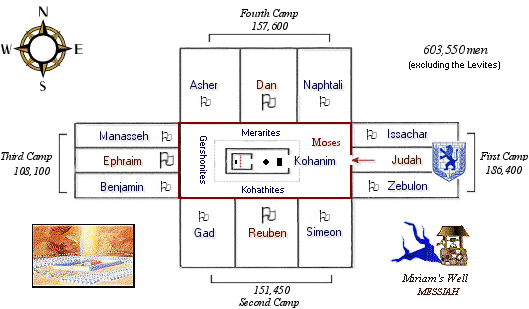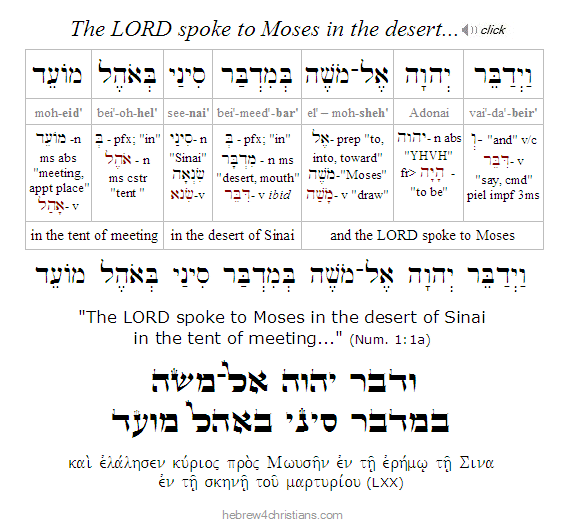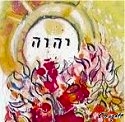|
|
 |
 |
 |
 |
|
Weekly Torah Reading
|
|
|
|
Parashat Bamidbar ("in the desert")
|
|
|
Click on the links to display the Scriptures:
|
|
|
|
 |
 |
 |
|
Torah Reading Overview
|
|
|
|
Bamidbar (בּמדבר) means "in the desert" and is also the name given to the fourth book of the Torah (i.e., Numbers). It begins with the census of the tribes (i.e., shevatim: שבטים) and instructions about the arrangement of the Israelite camp. The Levites are not included with the others in the census, since they are responsible for the mishkan (Tabernacle), and have a special status within the nation.
The parashah begins:
|
|
|
 |
 |
|
The LORD spoke to Moses in the wilderness of Sinai, in the tent of meeting, on the first day of the second month, in the second year after they had come out of the land of Egypt, saying, "Take a census of all the congregation of the people of Israel, by clans, by fathers' houses, according to the number of names, every male, head by head." (Numbers 1:1-2)
|
 |
 |
|
The Command for a Census
|
 |
 |
|
As explained in parashat Ki Tisa, the LORD had Moses take a census in order to raise funds for the construction of the mishkan and to provide atonement for shed blood during battle. This collected money was called kesef hakippurim, atonement money, and was to be melted down to create the 100 adanim (sockets) used to hold the pillars of the mishkan (tabernacle).
In this parashah, a command for another census was given on Iyyar 1 of the year 2,449, exactly one month after Rosh Chodashim and the dedication of the mishkan (as explained in parashat Tzav). The sages state that the LORD waited 30 days after the dedication of the mishkan to take the census in order to let Israel mourn for the death of Aaron's sons Nadav and Avihu.
Just as a king counts his army on the day of his coronation, so the LORD counted all the men (from age 20 upward) who would serve in the Jewish army and who would be able to help conquer the Promised Land.
Like the earlier census, the men were counted by means of a half shekel coin (according to Midrash, the reason for this is that as each Jew is being counted, Satan takes note and accuses them before the LORD as a transgressor, calling for the punishment of his sins. The use of the half shekel, then, was a means to outwit the accuser). In addition, each man also had to provide documents that proved what shevet (tribe) from which they descended.
Moses (and the chiefs of each tribe) counted a total of 603,550 men of draftable age (20 to 60 years) in Israel. Of these, 22,273 were firstborn sons. The tribe of Levi, however, was not counted with the other tribes, since they were separated to serve in the mishkan.
|
 |
 |
|
Note that each tribe's flag color corresponded with the color of its respective stone in Aaron's breastplate (Exod. 28:15-21). For example, Judah's stone was a sky-blue carbuncle and therefore the color of his flag was like the color of the sky with a "fiery lion" embroidered upon it (Gen. 49:9).
According to midrash, a watergiving rock accompanied the Israelites in the desert (the rock was later called the "Well of Miriam"). Whenever the Israelites prepared to camp, the 12 nesi'im (leaders of the tribes) would sing praises to the LORD, and the rock would gush forth four streams of water. One stream surrounded the mishkan, another surrounded the camp of the Levites, and another surrounded all the Israelites. The fourth stream marked out the boundaries for each of the 12 tribes of Israel.
It is fascinating to note that the Apostle Paul correlated the life-giving Rock that provided supernatural water for the Israelites with the Mashiach Yeshua (1 Cor. 10:4). In other words, Yeshua Himself was the source of life for the Israelites as they wandered in the wilderness of Sinai. It is still true to this day....
|
 |
 |
|
The LORD commanded that a separate census of the clans of Levi be taken. Unlike the census of the Israelite males 20 years and older, the Levite males were to be counted from one month old and up.
Why a separate census? Rashi gives two explanations. First, they had special responsibilities in the mishkan and "it is appropriate for the King's legion to be counted separately." Second, the LORD foreknew that the Sin of the Spies would evoke a decree and all who were counted would die during forty years of wandering in the desert. God did not want the tribe of Levi to be included in this decree because they did not sin with the Golden Calf (Rashi's second explanation is odd, since we know that the entire wilderness generation died off (except for Joshua and Caleb), including the Levites, before Israel was able to enter the Promised Land (Num. 14:28-30)).
The result of the Levite census was 22,300 males, by far the smallest of the tribes. One reason given for the low number comes from Rambam, who said that since the Levites were never forced into hard labor by Pharaoh, the promise of the LORD to multiply those shevatim that were oppressed in Egypt did not apply to them (Ex. 1:12).
When Israel was led (by the pillar of fire) to a new location during their wilderness wanderings, the three Levite clans first dismantled and transported the mishkan and reassembled it at the center of the next encampment. They then set up camp around it: the Kohathites, who carried the Mishkan vessels (the ark, menorah, etc.) camped to the south; the Gershonites, in charge of its tapestries and roof coverings, to the west; and Merrarites, who transported its wall panels and pillars, to the north. Before the Mishkan's entrance to the east were the tents of Moses, Aaron and the Kohanim.
Even afterwards, when Israel went into the promised land under the leadership of Joshua, the land was apportioned to the tribes largely according to their order of encampment in the desert, as has been pointed out by several biblical commentators. Except for the royal tribe of Judah, located in the "center" of the country around Jerusalem, the rest of the tribes remained close to the allotments of their brethren for long periods of time, just as they marched with them in the desert.
|
 |
 |
 |
 |
 |
|
 |
 |
 |
 |
 |
 |
|
The Firstborn Exchanged for the Levites
|
|
|
Before the Sin of the Golden Calf, the firstborn son of each Jewish family was to perform avodah (service to the LORD) by offering korbanot on behalf of their family (Ex. 13:2). However, when the firstborn sons of Israel later took part in the idolatry, they sadly forfeited this right. Only the clans of the tribe of Levi did not forsake the LORD when Moses was upon Mount Sinai, and the LORD honored them with special status in Israel.
The LORD commanded Moses to exchange the roles of the firstborn son to the Levites, who would then serve Him in the mishkan. However, there was a problem. There were 22,273 firstborn Israelites to 22,000 Levites (300 Levites could not be used for the exchange, since they were firstborn sons themselves). To offset the difference, a special census tax of 5 shekels would be required of the 273 sons (the firstborn Israelite sons who paid were selected by lot).
|
|
|
|
The Significance of the Census
|
|
|
The census, among other things, indicates that the LORD is a God of orderliness who is concerned for each member of the community. Every Jew is uniquely created and known by the LORD, and not one is unseen or forgotten. Rashi makes the famous statement:
|
|
|
 |
|
|
|
ke'ish echad b'lev echad
|
|
|
|
As one man with one heart
|
|
|
|
Though each Jew was accounted for before the LORD, all of Israel was mishpachah, a family, a united people with whom the LORD was God and Father. This family had specific roles and functions, each of which was not to be performed by others. For example, the Levites were forbidden to do the work of the Kohanim, and vice-versa. Even within the Levites themselves, each clan was assigned its own unique role.
|
|
|
Duties of the Kohathites
|
|
|
The LORD further commanded that a census of the sons of Kehat ("Kohathites") be taken. These men would be responsible for carrying the most sacred objects of the mishkan: the Holy Ark, the shulchan, the menorah, and the two altars (the altar of incense and the brazen altar).
The sacred objects were not to be transported using any means other than upon the shoulders of the men of Kehat. Moreover, none of these sacred objects were to be looked upon or touched by the Kohathites (or any other Levite), upon pain of death.
Before every journey, the kohanim clan was ordered to carefully wrap these objects. Each object had its own wrapping. When covering the Aron Kadosh (Holy Ark), the kohanim would walk backwards and drape the parochet over the ark. Next it was wrapped it in a waterproof layer of "tachash" skin. Finally the ark was covered with a cloth of techelet (wool dyed blue), a symbol of heaven.
The Kohanim also carefully covered the other sacred objects. The shulchan (table of showbread) was wrapped in techelet and then covered with tachash skin, as were the menorah and the altar of incense. The copper mizbe'ach (brazen altar) was a bit different, since it always had heavenly fire in the shape of a lion that rested over it. Before every journey, the Kohanim would put a metal cover over the fire and then spread a purple cloth over the altar itself. Finally the entire altar was covered with an outer layer of tachash skin.
It was only after all this preparation that the Kohathites were permitted to come and move these sacred objects when the Israelites decamped. To ensure order in this process, the LORD commanded Aaron's son Elazar (a kohen) to oversee the work of Kohathites and to ensure that the objects were properly covered before they were moved. Elazar was also appointed to carry the shemen (oil) for the menorah, the ketoret hasamim (fragrant incense), the minchat hatamid (daily grain offering), and the anointing oil. He was further commissioned to oversee the entire mishkan and its operation.
|
|
|
 |
|
|
|
Haftarah Reading Overview
|
|
 |
 |
|
In the day when the Mashiach returns, the Jewish People will again be called "My People" and "Sisters who have regained God's Mercy." Meanwhile, the children of Israel are urged to chastise their Mother Israel, who has reduced herself to the level of the unfaithful wife. Therefore, the LORD will punish Israel and remove her from the joy of the land.
Nonetheless, God will have mercy on Israel yet again, and turn all the harsh punishments into great blessings. The LORD will "speak tenderly" to Israel and restore her to condition when He ransomed her from bondage in Egypt:
And I will betroth thee unto me for ever; yea, I will betroth thee unto me in righteousness, and in judgment, and in lovingkindness, and in mercies. (Hos. 2:19)
In the coming millennial kingdom, when Yeshua the Mashiach reigns in Jerusalem, the Jewish people who survived the tribulation will at long last be fully restored as God's covenant people upon the earth.
|
 |
 |
|
In other words, there has always been provision for the nations to come into relationship with YHVH through the grace of God. Although the ethnic Jews consider themselves to be am segulah, a treasured people, ever since Abraham (the very first "Jew") the LORD had intended to call out people from every tongue and tribe to be His own children.
In the end there will be "one new man," a redeemed group of peoples - both Jew and non-Jew - who will live in covenant with the LORD forever and ever.
In light of the sovereign plan of God, this segment of Romans concludes with the contrast of the ways of justification as espoused by Judaism and Christianity, respectively:
What shall we say, then? That Gentiles who did not pursue righteousness have attained it, that is, a righteousness that is by faith; but that Israel who pursued a law that would lead to righteousness did not succeed in reaching that law. Why? Because they did not pursue it by faith, but as if it were based on works. They have stumbled over the stumbling stone, as it is written, "Behold, I am laying in Zion a stone of stumbling, and a rock of offense; and whoever believes in him will not be put to shame."
Blessing:
|
 |
|
|
 |
|
|
 |
 |
|
For Further Study:
|
|
|






